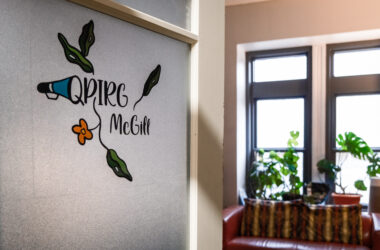On Feb. 29, artist, writer, curator, and filmmaker asinnajaq took to Zoom to give a talk on their artistic practice and works. The talk was organized as part of the Disrupting Disruptions: Feminist and Accessible Publishing, Communications, and Technologies speaker and workshop series in collaboration with the Indigenous Futures Research Centre (IFRC) at Concordia University, an organization that supports Indigenous-led research.
Disrupting Disruptors is a series that unites diverse disciplines such as computer science, feminist studies, LGBTQIA+ studies, and critical race theory to explore “critical approaches to publishing practices, innovative communication strategies, and techniques for making research dissemination more accessible.” The Institute for Gender, Sexuality and Feminist Studies (IGSF) at McGill also provides financial and administrative support for the series.
Remarking that “making slideshows is one of [their] love languages,” asinnajaq began their presentation by discussing some of the methods and core values that they bring to their work. They noted the importance of asking themself “Am I the person to do this?” when approaching a project and reflecting on how they can bring their unique perspective to the art, as well as doing research and listening to others to best explore the subject at hand.
asinnajaq then described several of their mixed media artistic projects, such as the installation Where you go I follow, which incorporates a photograph printed on a fabric sheet and written scores. They also detailed their installations Nuna and qulliq as part of the exhibit ᐊᖏᕐᕋᒧᑦ / Ruovttu Guvlui / Towards Home, which originally appeared in the Canadian Centre For Architecture. asinnajaq’s work in the exhibit included creating an augmented reality (AR) artwork as part of Geronimo Inutiq’s installation, which audiences could view using Microsoft Hololens. The AR exhibit depicted an ever-changing landscape in the gallery room—clouds hanging overhead, a running river, and iridescent ravens swooping from perch to perch.
“[This] installation to me was really about Iqaluit and about the feeling of being there,” asinnajaq said. “One thing that I could see that I could really add to make it feel like Iqaluit was to add something about the atmosphere and some environmental elements like the clouds, the water. And […] we have the Raven which are iconic for their tenacity […] and their character.”
asinnajaq finished their presentation by discussing their 2017 documentary short film, Three Thousand, which they created out of archives from the National Film Board of Canada. They explained that the film uses roughly 100 years of archival representations of the Inuit to create a “timeline of colonization and our cultural fabric.”
During the question and answer period, asinnajaq spoke to the way the film is for them “a document primarily for Inuit so that we can see and understand how we got to where we are,” while also underscoring the possibilities for change.
“Because there are some people, some fellow Inuit that I know, that sometimes forget […] the situation we’re in with really precarious situations with mental health, housing, food, safety, security […] and trauma that so many people are moving through is not an inherent part of us, and it’s happening for a reason,” asinnajaq said. “While doing that, I always want to leave space for hope […] that we can create worlds that we want [….] This world is a created world, and we can create worlds.”
Alex Ketchum—the organizer of Disrupting Disruptions and Assistant Professor at the IGSF—spoke to the connections between asinnajaq’s work and the themes of the series in an email to The Tribune.
“The asinnajaq event came about due to my partnership with the Indigenous Futures Research Centre,” Ketchum wrote, noting that their “work thoughtfully engages with technology.”
IFRC programming coordinator Joëlle Dubé explained in an email to The Tribune that the organization’s collaboration with Disrupting Disruptions for the speaker series was motivated by an interest in exploring disciplines in science, technology, engineering, art, and math (STEAM), as well as from Indigenous, queer, and feminist perspectives.
“Whereas the acronym used to be STEM, we were curious to delve deeper into the role arts can play as the latest inclusion within this cluster of disciplines,” Dubé wrote. “We thought that the way asinnajaq makes use of new technology, through their work as a filmmaker, an artist, and a curator exemplifies a not-yet-presented perspective or facet of STEAM, one that pertains to visual storytelling.”
The next event in the Disrupting Disruptions Series is a workshop by Gabryelle Iaconetti and Liam Devitt on Queer Oral Histories on Mar. 15.








